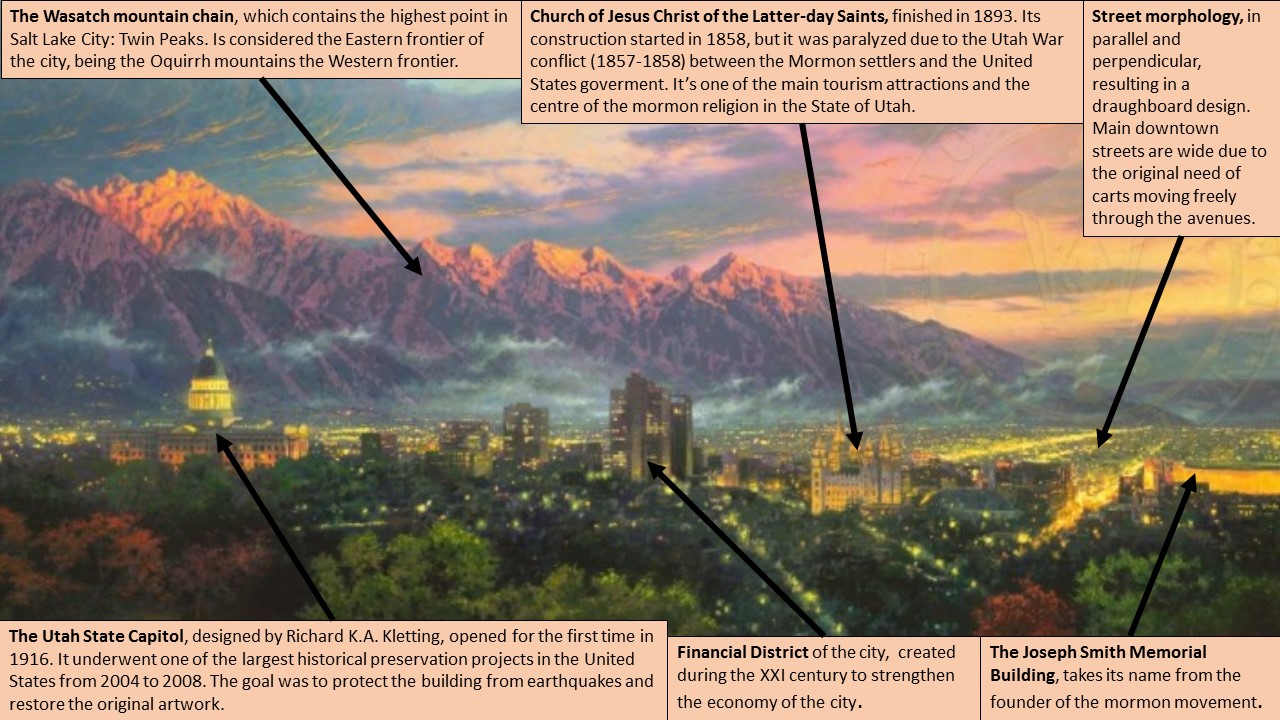SALT LAKE CITY (Thomas Kinkade, 2005)
This painting is entitled “Salt Lake: City of Lights” and the author is the very well-known American artist Thomas Kinkade (1958-2012). It was made in the beginning of the XXI Century and represents a view of Salt Lake City, in 2005. The painting captures the city of Salt Lake at sunset, and displays some significant urban elements such as The Church of Jesus Christ of Latter-day Saints, The Joseph Smith Memorial Building, named after Joseph Smith, founder of the Mormon religion, and The Utah State Capitol, which is the headquarter of Utah State.
Salt Lake City is situated to the North of the Utah State and to the Northeast of The Salt Lake Valley, surrounded by the Great Salt Lake to the Northwest and the Wasatch and Oquirrh mountains in the Eastern and Western frontiers respectively. The Great Salt Lake is separated from the main city by large swamps and marshlands, and the metabolic activity of the bacteria within them gives birth to a phenomenon known as “lake stink”, a scent that is reminiscent of rotten eggs, twice a year during a few hours. The highest point in Salt Lake City is Twin Peaks, at the Southeast of the Wasatch mountain chain. This mountain chain, with the Oquirrh hills and the Great Salt Lake defines the topographic characteristics of the city.
The city plan is based on parallel and perpendicular streets that meet on the main points of the city, such as The Church of Jesus Christ of Latter-day Saints, The Joseph Smith Memorial Building and The Utah State Capitol among others. This street distribution results on a draughboard design. The main downtwon streets are extremelly wide, due to the original idea that took into account that a cart could easily move in any of the avenues. The Church of Jesus Christ of Latter-day Saints started its construction the 6th of April of 1854, but during the Utah War the foundation of the church was burried. It stayed this way until 1858, when the efforts of constructing the temple were resumed and it was discovered that the original foundation had crumbled. A new quartz foundation replaced the old one and the temple was successfully finished in the 1890s. Today it is one of the main touristic attractions of the city and also the centre of the Mormon religion in the State of Utah. The interior of the Church is strictly prohibited for those who aren’t mormons, but the square of the Temple is full of volunteers and missionaries that gently offer 30 minutes tours in 30 different languages.
To our left, we can see the Utah State Capitol, a building designed in 1916 by local architect Richard K. A. Kletting, who also designed the Enos Wall Mansion, now a landmark for the Last-day Saints Bussiness College campus. This Capitol underwent one of the largest historical preservation projects in the United States from 2004 to 2008. The Project had as its goals to protect the building against posible earthquakes and to repair and restore the original artwork. We can also appreciate on the right section of the painting the Joseph Smith Memorial Building, that was built betwenn 1909 and 1911. This building takes its name from Joseph Smith, founder of the Latter Day Saint movement (also known as Mormon religion). Its location is on the corner of the Main Street and South The Church of Jesus Christ of Latter-day Saints. At the centre of the canvas we can appreciate skyscrappers who are the result of more modern city designs as well as the creation of a Central Business District for the city.
A mayor for the city was chosen for the first time in 1911, Samuel C. Park, who focused in updating the precarious infrastructures of the city. In 1929, due to The Great Depression, lots of the citizens lost their jobs and homes and were forced to live in the streets. However, by the end of the World War II the city rose and recovered its economy. During the XXIst century a Financial District was created in order to strengthen the economy of the city. Salt Lake City held the Winter Olympic Games in 2002, and due to its dinamic and cosmopolitan society, it is no surprise that nowadays is a city where various artistic and cultures currents meet, making Salt Lake City one of the most liberal cities in the United States.
Íñigo Monje Vigón

